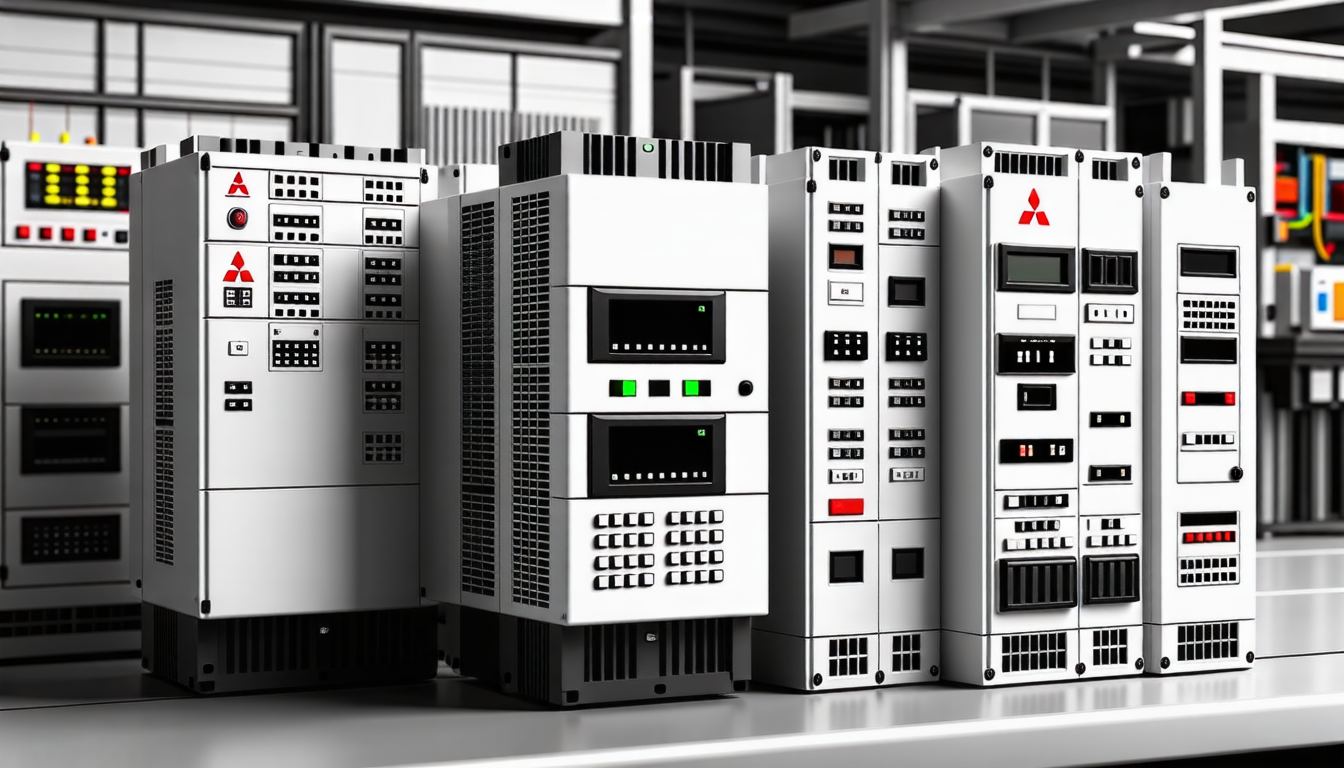|
IN BRIEF
|
The use of extension modules in Mitsubishi Electric Programmable Logic Controllers (PLCs) plays a pivotal role in enhancing system capabilities and customization. These modules are designed to expand the functionality of the core controller, accommodating a variety of input and output requirements within diverse production environments. Mitsubishi’s MELSEC-L Series and FX5 safety extension modules exemplify how modularity allows for tailored solutions that meet specific operational demands. Users can integrate up to 40 branches of extension modules, ensuring scalability as production needs evolve. With features such as opto-isolation, simplified setups, and efficient memory management for safety devices, these modules not only ensure operational efficiency but also facilitate a smoother recovery process in critical situations.

Extension modules are an essential part of automation systems, allowing engineers to tailor their Mitsubishi Electric PLCs to specific operational needs. These modules provide flexibility in system design, enabling integration with various sensors, actuators, and safety devices. The modular approach undertaken by Mitsubishi Electric promotes efficient scaling while ensuring operational integrity.
MELSEC-L Series Branch/Extension Module
The MELSEC-L Series incorporates branch and extension modules that enable users to expand their control capabilities rapidly. By providing the option to mount up to 40 modules, this module plays a pivotal role in accommodating diverse production environments. As production requirements change, the ability to customize system size significantly enhances adaptability and performance of the automation system.
This series of branch/extension modules not only extends the controller rack size but also supports various communication methods and protocols. Its design is focused on maximizing the potential of the L Series PLC, delivering an efficient, responsive backbone for industrial automation.
Modular PLC Family
Mitsubishi Electric has pioneered a modular automation platform, revolutionizing how control systems are structured. The modular PLC family allows engineers to mix and match functionalities, consolidating multiple performance features from different engineering applications into a single cohesive system. This modular philosophy promotes not only operational efficiency but also eases both installation and maintenance efforts.
Thanks to its modular nature, users can add or replace components without incurring significant downtime. This allows businesses to maintain high production levels while adapting to ever-evolving technical demands.
Quick Start Guide (Safety Extension Module)
One of the significant features of Mitsubishi’s extension modules is the Safety Extension Module. Designed for quick deployment, this module provides essential information, such as safety device settings and input/output status, directly accessible through its buffer memory. This feature reduces recovery time in the event of a fault or failure, making it an invaluable tool in maintaining uptime and safety standards.
Quick monitoring capabilities allow for prompt detection of anomalies and potential risks, thus significantly improving the overall safety of the operational environment. The Efficiency of this system enhances not only compliance with safety regulations but also operational reliability.
MELSEC-F Series I/O Extension
The MELSEC-F Series offers an I/O extension board engineered to add input and output terminals suitable for Mitsubishi FX3S or FX3G PLCs. This extension allows the integration of additional I/O points that are essential for expanding a system, particularly when working with a large array of inputs and outputs.
This design facilitates a compact solution, allowing users to build the board directly into the PLC. Such integration minimizes space requirements while promoting optimal workflow within the control panel setup, ultimately providing an efficient connection estate for automation projects.
FX5 Safety Extension Modules
As part of the advanced FX5 Series, the safety extension modules stand out for their ease of configuration. Intriguingly, these modules do not require any programming, which significantly reduces the setup time involved. Engineers can integrate safety features seamlessly without extensive preliminary programming tasks, accelerating the deployment process.
This hands-off approach not only simplifies installation but also ensures that operational safety is prioritized and adhered to without introducing complexity. Consequently, it allows operators to focus on production continuity while ensuring compliance with safety standards.
Application of Extension Modules
The application of extension modules spans various sectors, from manufacturing and assembly lines to process control and packaging. Their versatility means they can be implemented in diverse environments, adapting to unique demands of different sectors.
For instance, in manufacturing, having multiple I/O points allows for comprehensive monitoring and control of machinery, ensuring that all processes function optimally. In packaging, the ability to integrate sensors that monitor fill levels or packaging integrity can streamline operations and enhance product quality.
Networking Capabilities
The networking capabilities of Mitsubishi Electric PLCs further enhance the functionality of extension modules. These modules can be interconnected efficiently, forming a cohesive network that supports communication and data exchange between multiple units. This capability allows for the centralization of control, making management significantly more straightforward.
The integration of networking not only optimizes operational efficiency but also facilitates real-time monitoring and adjustments, leading to better resource allocation and overall performance. Additionally, remote access to the systems can elevate maintenance and troubleshooting processes, reducing potential downtime.
Benefits of Using Extension Modules
Utilizing extension modules in Mitsubishi Electric PLCs comes with a range of benefits. These include not only enhanced scalability but also improved resource management, operational flexibility, and reduced costs in the long term. The modular design reduces the need for entirely new PLC units when expanding or modifying an existing system, offering a cost-effective alternative.
Moreover, the simplicity of expanding capabilities through the addition of modules rather than overhauling entire systems translates to fewer interruptions in production. As a result, businesses can efficiently adapt to changing demands, maintaining productivity while minimizing disruption.
Integration with Other Mitsubishi Products
Extension modules work synergistically with other Mitsubishi Electric products, enhancing their effectiveness further. For instance, when combined with advanced HMI (Human-Machine Interface) systems, users can achieve a higher level of process visualization and control. This integration empowers operators with real-time insights, ensuring that they can respond swiftly to any operational anomalies or shifts in production requirements.
Moreover, compatibility with software solutions developed by Mitsubishi Electric offers additional functionalities. Through robust software tools, users can harness the full potential of their extension modules, optimizing processes, and enhancing data analysis.
Future Trends in Extension Modules
The landscape of extension modules continues to evolve, with a focus on increased automation and smarter technologies. Trends indicate a move toward modules that offer enhanced functionalities, such as advanced diagnostics, predictive maintenance capabilities, and connectivity with IoT devices.
This foresight into the future of automation emphasizes the commitment of Mitsubishi Electric to remain at the forefront of technology. By continually innovating and enhancing extension module functionalities, they play a pivotal role in shaping the next generation of industrial automation solutions.
Conclusion on Mitsubishi Electric Expansion Modules
The flexibility, efficiency, and user-friendliness of Mitsubishi Electric’s extension modules offer substantial advantages across numerous industries. With a robust lineup supporting seamless integration and networking capacities, these modules position businesses to thrive in an increasingly complex industrial landscape.
Ultimately, the strategic incorporation of extension modules into automation systems not only equips engineers with the tools necessary for effective production management but also enhances the overall responsiveness of the manufacturing process, ensuring sustainability in the long run.
The Mitsubishi Electric PLCs feature a variety of extension modules designed to enhance the capabilities and flexibility of modular automation systems. Among these, the MELSEC-L Series branch and extension modules facilitate the customization of system configurations to align with the specific requirements of a production facility, allowing for the integration of up to 40 modules. Additionally, the FX5 safety extension modules streamline the setup process without the need for programming, bolstering safety and efficiency. As part of the Mitsubishi modular PLC family, these extensions underscore the commitment to delivering comprehensive solutions for diverse industrial automation needs.
FAQ on Extension Modules for Mitsubishi Electric PLCs
What is the purpose of the MELSEC-L Series Branch/Extension module? The MELSEC-L Series Branch/Extension module is designed to expand the system to accommodate the varying sizes of production facilities. It allows for the mounting of up to 40 additional modules.
How does the modularity of the L Series PLC system benefit users? The modularity provides flexibility by allowing users to customize their control systems to meet specific application needs, integrating various features from different engineering solutions.
Can I check safety device settings using the Quick Start Guide for the Safety Extension Module? Yes, the Quick Start Guide enables users to verify safety device settings and input/output statuses within buffer memory, which significantly reduces recovery time in the event of an issue.
What are the functionalities of the MELSEC-F series I/O Extension? The MELSEC-F series I/O extension board is specifically designed to increase the number of input and output terminals in FX3S or FX3G PLCs, and can be integrated directly into the PLC.
Are the FX5 safety extension modules user-friendly? Yes, the FX5 safety extension modules simplify the setup process as they do not require any programming, enabling quicker deployment of safety solutions.
What type of input blocks are available for the Mitsubishi Electric PLC Expansion Module? The input blocks provided are opto-isolated, supporting both 24Vdc sink or source configurations to accommodate NPN or PNP sensors, while output blocks can be configured with either relay or transistor outputs.
What advantages does the L Series Modular Controller offer? The L Series Modular Controller combines compact size with easy expandability, enhanced networking capabilities, and a wealth of built-in features to streamline automation processes.
What key specifications should I know about the L Series Branch Extension Module? The L Series Branch Extension Module serves as an essential accessory that facilitates the expansion of the system to cater to diverse operational requirements.
How do Q-Series extension racks differ from L Series modules? Q-Series racks function as main racks requiring a power supply and a CPU, while L Series modules function as extension units that enhance the capabilities of existing systems.

